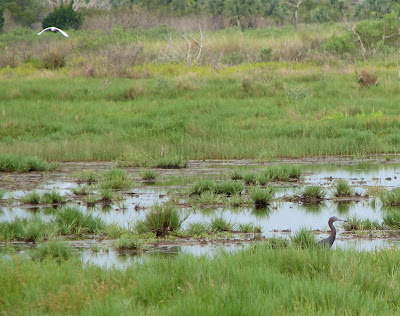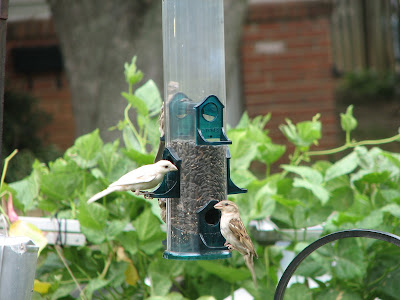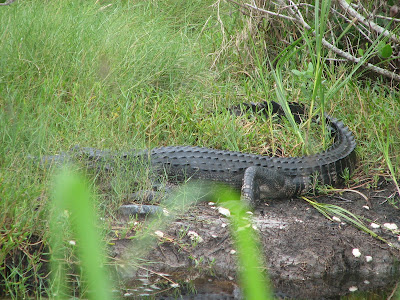On our recent Disney World vacation, we enjoyed Disney’s Epcot, Magic Kingdom and Hollywood Studios parks but never made it over to Animal Kingdom. You might wonder why a naturalist would give up the chance to visit a zoo that has exciting rides AND live animals. It’s not that I have an ethical bias against zoos, that I didn’t like this park on our last visit, or even that we couldn’t wake up in time to see early-rising animals. Instead, we found just as much discovery, beauty and excitement (maybe more excitement than we’d bargained for) as Animal Kingdom would have offered, with lots less crowds too.
Instead of Animal Kingdom, we decided to visit Merritt Island National Wildlife Refuge and Canaveral National Seashore, both in Titusville. You need a car to get there from Disney World in Orlando, but it’s definitely worth the hour drive. We arrived at the refuge roughly mid-day. Even that late, there were still lots of animals out and about, including some of my target species.
It had rained every day of our visit so far, and we’d already pushed the Merritt trip back a day. The morning looked fine when we set out, but soon a huge ominous bank of clouds appeared over the horizon. By the time we got to the refuge, the air felt like a storm was about to break, and dark angry clouds were nearly overhead. So we ducked into the VC for the briefest of chats with the staff, then optimistically slathered on bug repellent and entered the short boardwalk trail. The threatening storm front definitely added as much urgency and danger to our wildlife watching as we found on any thrill ride back at Disney. Although our pace was rushed, we still found lots of cool critters along the boardwalk: tiny lizards, tropical butterflies, dragonflies, and of course those tremendous spiders I mentioned last entry.
 |
| Queen butterfly |
|
|
|
|
 |
| Wandering through oaks, palms and Spanish moss. |
 |
| A non-native Brown Anole |
After we finished the boardwalk we could hear distant thunder but still no rain had fallen. Our next destination was the Scrub Ridge trail, where I hoped to spot a Florida Scrub-jay. We didn’t find any Scrub-jays, but did see several Gopher Tortoises, so named because they dig long burrows. They were pretty shy, and usually we’d spot them from about 15 feet away, at the same time they saw us. At that point they’d trundle hastily into the underbrush. Once under cover they were invisible but we could easily tell their location from the scuffling sounds. After maybe the fifth similar encounter we couldn’t help but giggle every time we saw or heard another one. Apparently the Gopher Tortoises are pretty important for the scrub ecosystem: lots of other animals use their burrows for homes too, whether as daily shelter or to escape the fires that regularly sweep the area in order for it to remain scrubby, not forested.
 |
| Gopher tortoises on the trail. The far one just spotted us. |
Another animal we saw everywhere on the trail was the tiny Oak Toad, only about an inch long. They were so abundant in spots, and so well camouflaged, that I barely avoided stepping on a few. I remember thinking the toads seemed nearly to glimmer against the trail (although maybe that was just air shimmer from the heat). These are the smallest native toads in the US, and are one of the few that is active in daytime. Pretty cool.
 |
| Oak Toad |
Roughly halfway down the trail we decided the clouds looked way too scary and close for comfort, so we turned back. We made it to the car in a cloud of mosquitoes, but still no actual raindrops had fallen. (Note to anybody considering a visit to Merritt: wear long pants and a long-sleeved shirt even in the hottest weather! My pants did a much better job protecting me from mosquitoes than bug repellant did on bare skin, probably because I kept sweating off the repellant no matter how often I applied it.)
 |
| Threatening clouds over the scrub habitat. |
Next we headed to look for endangered West Indian Manatees. I’ve always wanted to see wild manatees. We’d seen captive ones the day before at Epcot’s Living Seas exhibit, but it's just not the same. The area we were directed to was much further away than I had thought; in fact Victor had just said “I think we’ve gone too far, let’s turn back” when I finally spotted a sign for the turn-off. We pulled into the gravel parking lot and joined a couple other families already on the concrete overlook. Right below our feet we saw manatees lolling in the warm shallow water. Wow! There was even one a bit farther away munching on floating plants.
The manatees were very tough to photograph. Mostly they floated just under the murky water surface, occasionally coming up for air. We were still anxious about the weather, and hadn’t yet gotten over to Canaveral to see the shuttle, so we didn’t spend a lot of time at the manatee spot. In the picture below, you can see white scars where the manatees had been hit by motorboats. That’s pretty common, I’ve heard, and is a big reason why they are on the federal endangered species list. The captive ones at Epcot were individuals who’d had severe injuries in the wild and were being treated and rehabilitated before release.
 |
| Two West Indian Manatees |
After the manatees we drove to the adjacent Canaveral National Seashore. We briefly checked out one of the beaches that had good views of the shuttle. There we also got a closer look at another Gopher Tortoise in the dunes, although it was as shy as the ones on Scrub Ridge trail and quickly scooted back under cover. There wasn’t a whole lot of other wildlife on that beach though; it’s not the season for migratory sandpipers and such.
 |
| Space Shuttle Atlantis |
 |
| Gopher Tortoise hiding in the dunes |
After the beach, we headed for Bio Lab Road, recommended to us by Canaveral’s contact station attendant. This turned out to be roughly five miles of skinny dusty road through marshy habitat, with occasional views of the seashore. It was thick with wildlife. Without leaving the car, we saw a Florida Wood Rat, a Marsh Rabbit, a Roseate Spoonbill, two Alligators, an Anhinga, both Great Blue & Little Blue Herons, Tricolored Herons, White Ibises and of course the ubiquitous Golden-silk spiders.
 |
| Marsh Rabbit |
 |
| Roseate Spoonbill |
 |
| White Ibis and Little Blue Heron |
Victor generously drove the whole time, allowing me to be wildlife lookout. This was my first time birding by car, and to be honest I was skeptical about the idea. How could I have a productive birding experience if we drove past wildlife before I even spotted it? But Victor was very good at driving slowly and stopping promptly when asked. Since we only saw two other cars the whole way, we could even safely back up to get better views or photos if we passed something before my mind registered “Hey, there was an alligator back there!”
 |
| A lurking alligator |
Around 4:00 we turned around and headed back for the refuge. I had wanted to pick up a T-shirt or two in the gift shop. But when we got to the VC area (at about ten past 4), we found even the gates into the parking lot were closed and locked. The posted hours were 10:00-4:30, and nobody answered the phone when we called the listed number. It was very disappointing and frustrating. I understand that sometimes things come up, but I really wish staff could at least have posted an explanation if not an apology. I had looked forward to buying that T-shirt as a way to support the park as well as to have a tangible memento of our visit. Instead, I ended up with a sour final impression. I didn’t even have the heart to take a last photograph of those locked gates.
But that’s the only thing that Merritt didn’t do as well as or better than Disney: customer service. And until that point, the customer service at Merritt & Canaveral had been pretty good. Everybody we talked to was polite and helpful, sending us correctly to interesting spots for wildlife. Even those ominous storm clouds never loosed a single raindrop, just added that spark of excitement.
I highly recommend visiting Merritt Island NWR and Canaveral National Seashore. Although you may have to work at it a little more, what with the longer drive and a grittier experience, for both wildlife and excitement I think a visit to Merritt Island & Canaveral beats a visit to Animal Kingdom. We had just as much fun and discovery at Merritt as we would have with Animal Kingdom’s rides and animal exhibits. Disney might have more animals in total and more guaranteed sightings, but because we discovered all the refuge animals ourselves, Merritt Island felt like more of a genuine adventure.
Side note: I found Merritt via the
Great Florida Birding Trail, a compilation of excellent birding sites throughout Florida, with tips for best times and key species or habitats. Virginia has one too, the
Virginia Birding & Wildlife Trail. They’re handy whether you live in the area or are planning a visit. The American Birding Association has compiled a list of
similar birding trails throughout the US too. Over thirty states are included. I’ll definitely check the listings before my next vacation.
This entry’s locations:










































